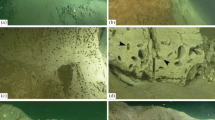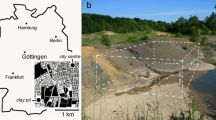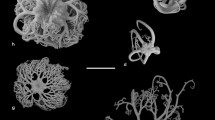Abstract
Echinocardium cordatum (Pennant, 1777) were collected in Normandy, France, in March and November 1985. The grooved frontal ambulacrum of the burrowing echinoid E. cordatum functions in transferring surface sediment from the apex to the mouth of the echinoid. Particles that fall down the burrow's chimney accumulate between the spines of the apical tuft and are taken over by specialized groove spines. Due to the slope of the groove and the type of floor spines it harbours, four successive regions can be recognized, namely the adapical region, the fasciolar region, the ambital region, and the adoral region. As a general rule aboral floor spines (i.e. club-shaped, golf-club-shaped, and isodiametric spines) function in gathering particles while propelling them mouthwards; they simultaneously embed particles in a mucous string. The oral floor spines (i.e. spatulated spines) function in hauling and guiding the mucous string towards the peribuccal area of the echinoid. Once facing the peribuccal area, particles are picked up by the peribuccal tube feet that either transfer them into the esophagus or scrape them out against the peribuccal spines. Spine-retained particles are either sucked up by the pumping action of the esophagus or fall to the burrow's floor where the tube feet may pick them up again. Together the apical tuft, the frontal groove, and the peribuccal area form an efficient food-collecting system that transfers trapped surface particles from the echinoid apex down to the mouth. Compared to that of most other spatangoids the frontal ambulacrum of E. cordatum is highly specialized. Such specialization is related to colonization of fine sediment, as is the occurrence of a chimney linking the burrow to the sediment surface. Actually the burrow's chimney is the only route for oxygen and food supply; it acts as a real ecological umbilical cord for spatangoids buried in fine sediment.
Similar content being viewed by others
Literature cited
Buchanan, J. B.: The biology of Echinocardium cordatum (Echinodermata: Spatangoidea) from different habitats. J. mar. biol. Ass. U.K. 46, 97–114 (1966)
Chesher, R. H.: The morphology and function of the frontal ambulacrum of Moira atropos. Bull. mar. Sci. 13, 549–573 (1963)
Chesher, R. H.: The systematics of sympatric species in West Indian spatangoids: a revision of the genera Brissopsis, Plethotaenia, Palaeopneustes and Saviniaster. Stud. trop. Oceanogr. 7, 1–168 (1968)
Chesher, R. H.: Contribution to the biology of Meoma ventricosa (Echinoidea, Spatangoidea). Bull. mar. Sci. 19, 72–110 (1969)
De Ridder, C.: Feeding and some aspects of the gut structure in the spatangoid echinoid, Echinocardium cordatum (Pennant). In: Proc. int. Echinoderm Conf. Tampa Bay, pp 5–9. Ed. by J. M. Lawrence. Rotterdam: Balkema 1982
De Ridder, C.: La Nutrition chez les Echinodermes psammivores. Etude particulière du Spatangide fouisseur, Echinocardium cordatum (Pennant) (Echinodermata, Echinoidea), 275 pp. Thèse de doctorat, Université Libre de Bruxelles 1986
De Ridder, C., Jangoux, M. and E. Van Impe: Food selection and absorption efficiency in the spatangoid echinoid, Echinocardium cordatum (Echinodermata). In: Proc. int. Echinoderm Conf. Galway, pp 245–251. Ed. by B. F. Keegan and B. D. S. O'Connor. Rotterdam: Balkema 1985
Ferber, I. and J. M. Lawrence: Distribution, substratum preference and burrowing behaviour of Lovenia elongata (Gray) (Echinoidea: Spatangoidea) in the Gulf of Elat (Aqaba), Red Sea. J. exp. mar. Biol. Ecol. 22, 207–225 (1976)
Gandolfi-Hornyold, A.: Über die Nahrungsaufnahme der Spatangiden. Biol. Zbl. 29, 759–762 (1909)
Gandolfi-Hornyold, A.: Beiträge zur Biologie und Anatomie der Spatangiden. Mém. Soc. Sci. nat. Fribourg, (Zool. 1) 1, 25–67 (1910)
Gandolfi-Hornyold, A.: Über den Aufenthalt im Sand. Eingraben, Kanalbau und Schleimabsonderung der Spatangiden. Int. Cong. Zool. 9, 458–467 (1914)
Nichols, D.: The histology of the tube feet and clavulae of Echinocardium cordatum. Q. J. microsc. Sci. 100, 73–87 (1959a)
Nichols, D.: Changes in the chalk heart-urchin Micraster interpreted in relation to living forms. Phil. Trans. R. Soc. Lond. B 242, 347–437 (1959b)
Péquignat, E.: Biologie des Echinocardium cordatum (Pennat) de la Baie de Seine. Forma Functio 2, 121–168 (1970)
Smith, A. B.: The structure and arrangement of echinoid tubercles. Phil. Trans. Roy. S. Lond. B 289, 1–54 (1980a)
Smith, A. B.: The structure, function and evolution of tube feet and ambulacral pores in irregular echinoids. Paleontology 23, 39–83 (1980b)
Author information
Authors and Affiliations
Additional information
Communicated by O. Kinne, Oldendorf/Luhe
Rights and permissions
About this article
Cite this article
De Ridder, C., Jangoux, M. & De Vos, L. Frontal ambulacral and peribuccal areas of the spatangoid echinoid Echinocardium cordatum (Echinodermata): a functional entity in feeding mechanism. Mar. Biol. 94, 613–624 (1987). https://doi.org/10.1007/BF00431408
Accepted:
Issue Date:
DOI: https://doi.org/10.1007/BF00431408




